
This article was updated on January 7th, 2024
One of the most frequent questions I get asked as a veterinarian is “my dog has this rash. Is it an infection? What can I do at home to make him feel better until his appointment with you?” To understand how to make your dog’s skin feel better, we must first understand why the skin is infected. In this article, we will review the signs and symptoms of skin infections in dogs, the most common types of skin infections, and what you can do at home – and with your vet – to help your dog.
Signs and symptoms of skin infections in dogs
- Itchiness
- hair loss (alopecia)
- Crusting and flaking of the skin
- redness or rash (erythema)
- discharge or oozing
- pimples (often called pustules)
- musty smell (especially with yeast infections in the ears)
Common types of skin infections in dogs
We can break down skin infections in dogs into bacterial and fungal causes. In more severe cases, your dog may have both!
1. Bacterial infections
“Staphylococcus” species typically cause bacterial skin infections. Bacterial infections often cause:
- Redness,
- Pustules,
- Discharge
- You may also notice your dog itching, chewing, or excessively licking.
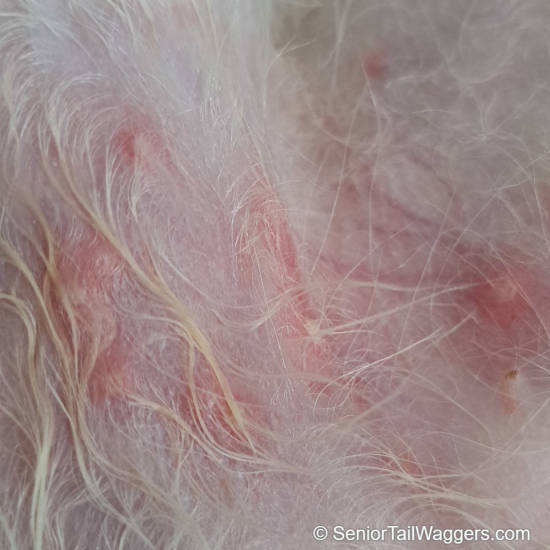
In the picture below, a bacterial infection caused redness (erythema), crusts, scaly flakes, and mild hair loss:
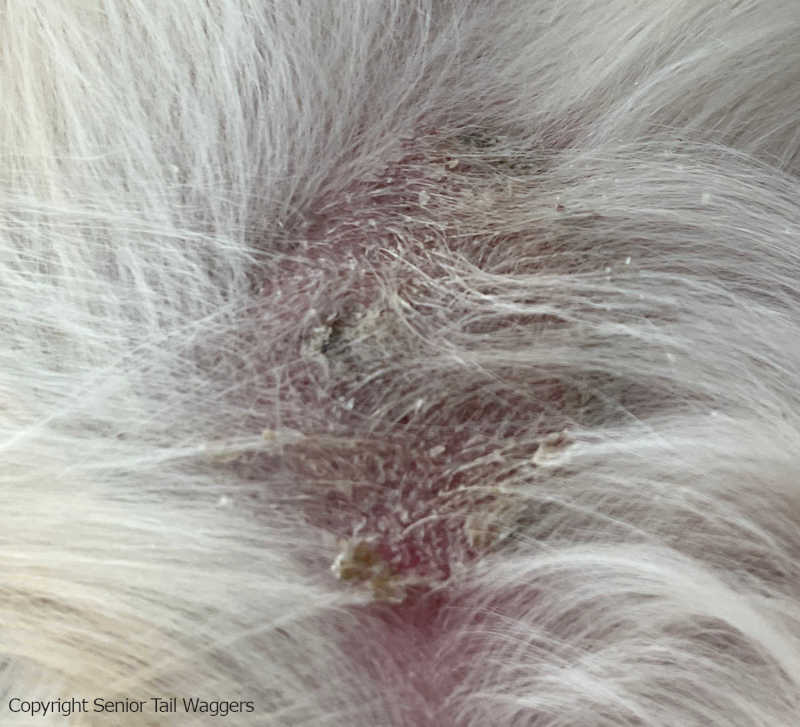
In the picture below, a bacterial infection also caused redness (erythema) and a moderate amount of scales or flakes of skin:
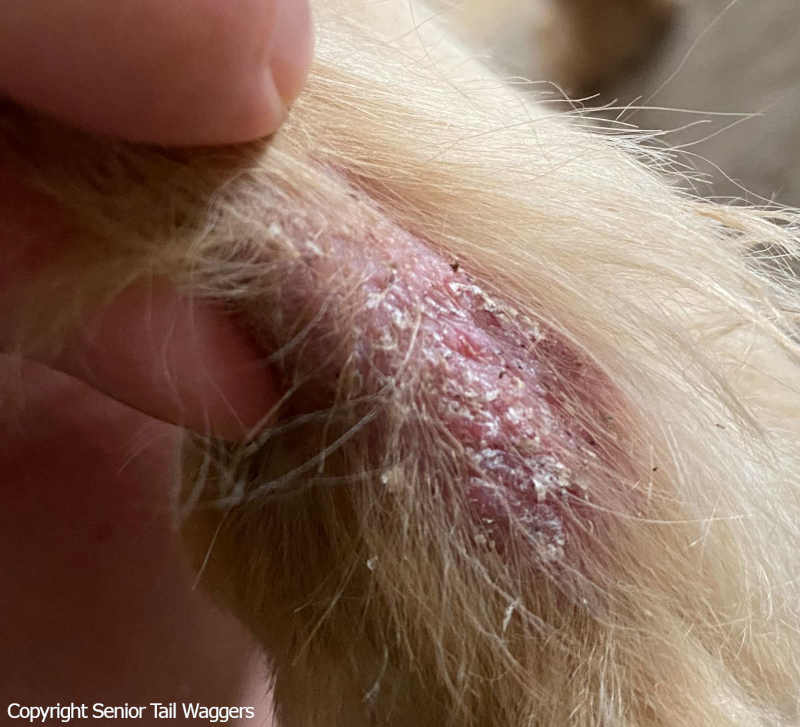
Treatment of bacterial infections: Infections in the skin’s most superficial or outer layers may be treated with topical antibiotic creams, ointments, or sprays. Bacteria that have penetrated deeper layers of the skin may need oral antibiotics to reach those tissues.
2. Fungal infections / ringworm
When a fungus is involved, there is frequently a musty or stale smell and the skin and fur can feel greasy. Other signs of a fungal skin infection can include:
- fur loss,
- skin thickening,
- mild to moderate itching.
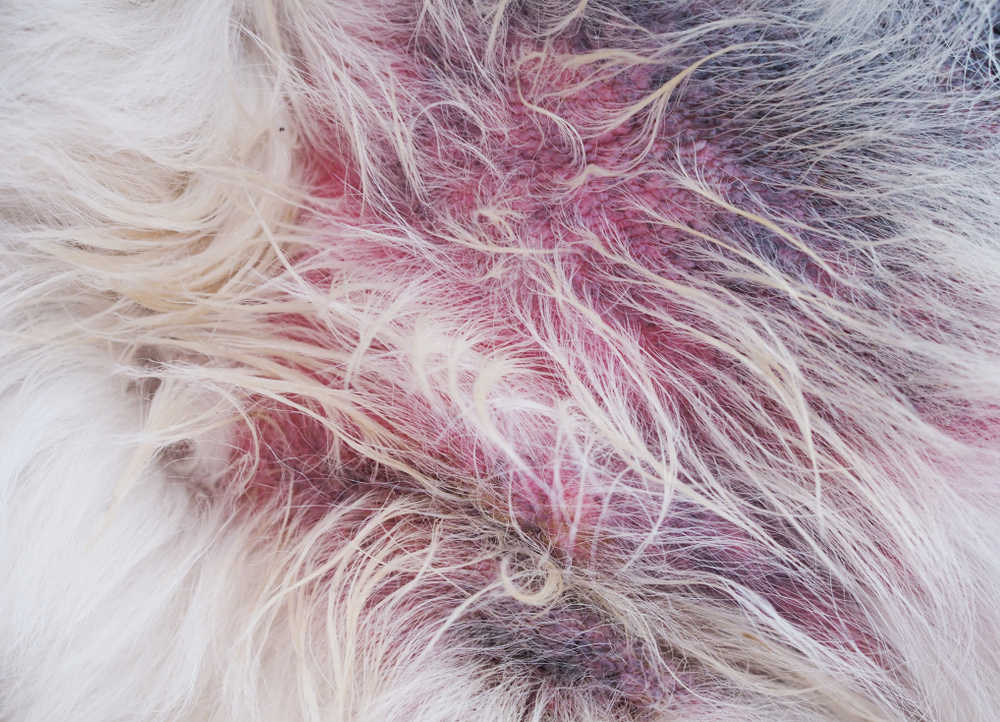
While there are multiple types of fungal infections, the one that worries most pet owners is ringworm (caused by Microsporum species) – see our article: Pictures of Ringworm in Dogs. Ringworm causes hair loss and scaly patches of skin, but it is not always in a “ring” presentation. This surprises many people since the infection has a more characteristic round or ring appearance on people.
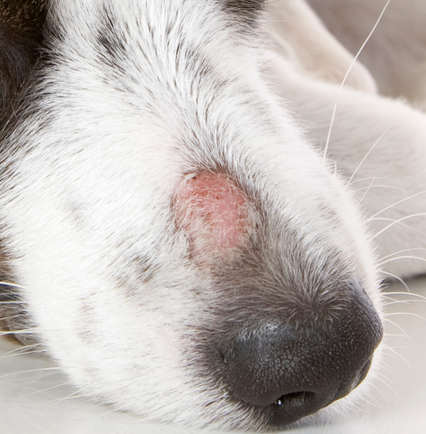
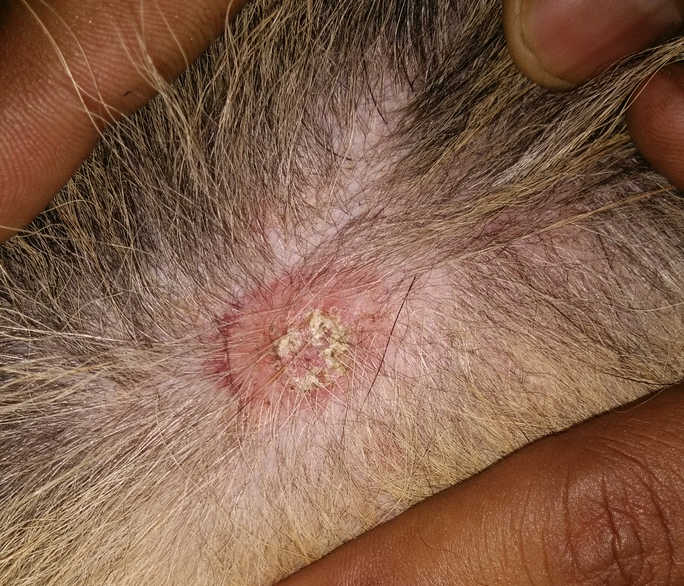
Let your veterinarian know if any person in the home has recent skin issues, especially with a ring or round appearance. Remember, your vet cannot diagnose skin issues in people, but knowing this might help their diagnosis or suspicion of ringworm.
Treatment of ringworm: A combination of topical ointments and oral antifungals is used to treat ringworm. Depending on the location and size of the fungal infection, your veterinarian may also recommend an antifungal shampoo. Treatment for ringworm is not a quick fix; it is common for treatment to last 4-6 weeks at least.
Environmental control of ringworm spores is critical to the success of clearing the infection as well. The hair your pet sheds will contain ringworm spores that then contaminate the environment, so frequent vacuuming and decontamination are essential. View more pictures of fungal infections in dogs.
3. Yeast skin infections
Yeast infections are another form of fungal infection. Malassezia is one of the most frequently seen skin infections, especially in ears, skin folds, and paw pads. Yeast has a distinct musty or sour smell. In chronic cases, yeast infections often cause skin thickening. View more pictures of yeast skin infections.
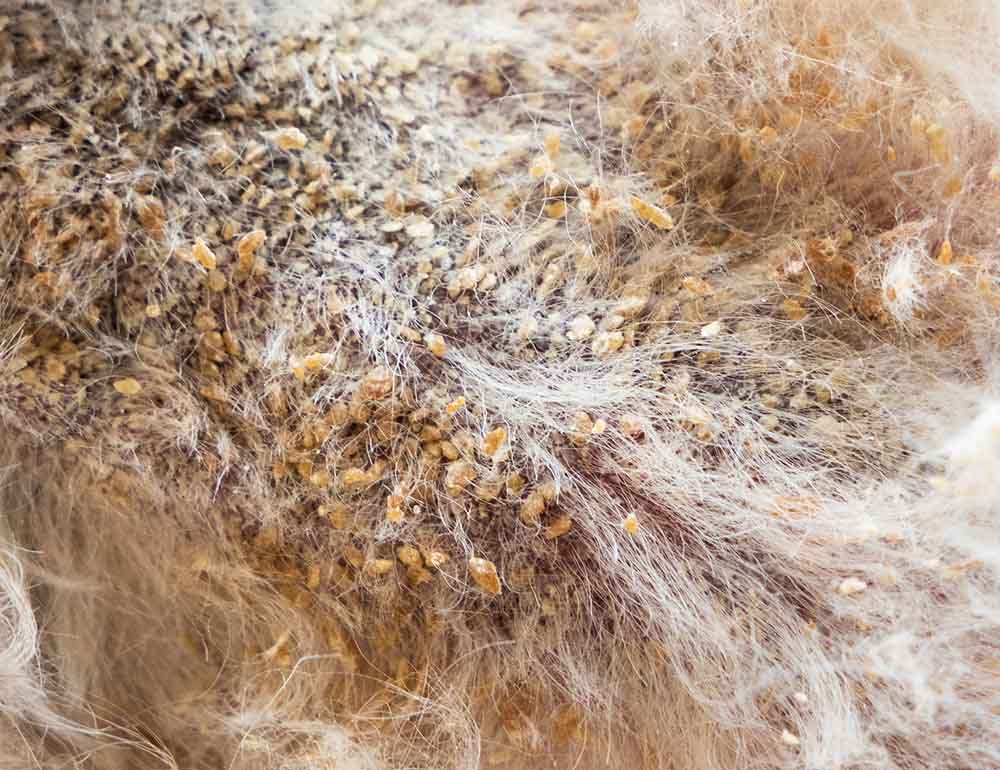
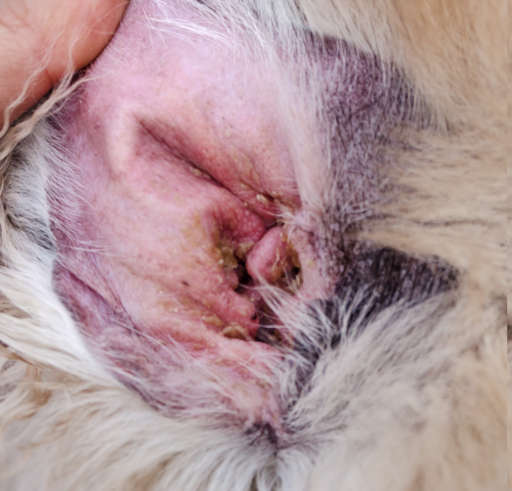
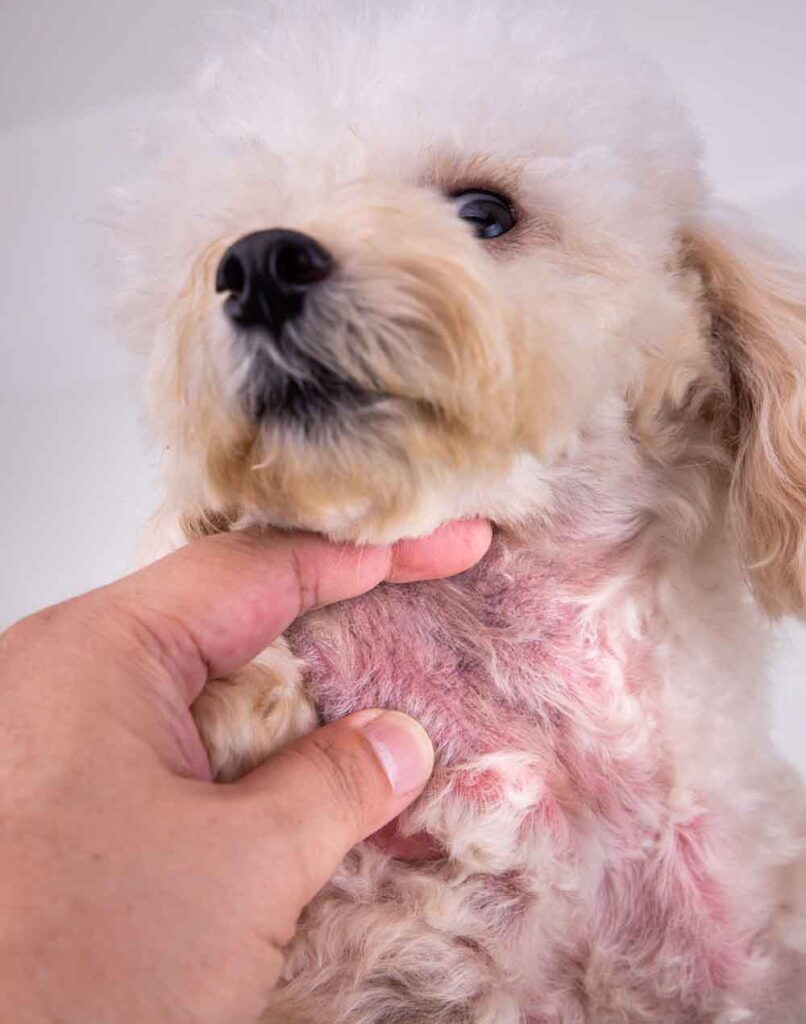
Here’s a list of signs that a dog may have a yeast skin infection:
- Itchy skin (excessive scratching or licking)
- Redness or inflammation
- Black spots on skin
- Rash or pustules
- Foul odor, often described as “yeasty” or “musty”
- Greasy or oily skin
- Hair loss or thinning coat
- Ear infections (yeast infections can spread to the ears)
Treatment of yeast skin infections: depending on the severity, these infections can be treated with oral or topical medications.
5 At-Home Remedies That Can Help (While Waiting for Your Vet)
It can be hard not to feel useless when your dog is uncomfortable or constantly itching. You want to find some sort of relief for them, and fast! Even if you can’t get antibiotics from your vet without an exam, there are some steps you can take at home to help:
1. A cool water bath or wash cloth: A cool water bath can often provide temporary relief and be quite soothing to the skin. Ensure the water isn’t too warm since that can have the opposite effect and be painful on the inflamed or infected skin. You can also try cool washcloth compresses over the affected areas if that is easier and if your dog will tolerate it.
2. An oatmeal-based shampoo can also temporarily soothe the skin. Oatmeal has anti-inflammatory and antioxidant properties that are beneficial to skin health. Most pet stores will have a variety of oatmeal shampoos – just remember not to bathe too frequently since that can dry out the skin and make a bad situation worse. Most vets recommend not washing your dog more than 2-3 times per month.
- ✅【Natural Plant-Based Patented Formula】Discover our exclusive dog shampoo and conditioner blend, made specifically for sensitive skin. Made with Organic Aloe Vera Gel, Almond Oil, Oatmeal, and essential Vitamins (A, D, E, B12). safe & effective for detangling and can be used daily. Say goodbye to wet dog odors and soothe hot spots and itching with our patented shampoo & conditioner blend. Treat your pet to the care they deserve!
3. A mild antibacterial soap like Dial: In areas that seem moist or have discharge, a mild antibacterial soap can be beneficial in keeping infection at bay until your dog’s appointment. Again, cool water, soap, and a washcloth can work wonders on mildly inflamed skin.
- Provides antibacterial effectiveness and moisturizing care
4. Keeping the area clean and dry: One of the most important – and often forgotten steps- is keeping the infected area clean and dry. As vets, we appreciate this is not easy with a dog. We recognize you can’t tell them to keep their feet clean, not roll in the mud, and not lick their wounds. But small things like wiping paws with a fragrance-free baby wipe when your dog comes in if he has an infected foot are essential steps in the treatment process.
5. A cone: Probably the least-liked suggestion (by dog and owner), but one that can have the biggest bang for your buck, is the cone or E-collar. This is critical if the infected skin is in an area that your dog can quickly lick or chew.

The cone prevents licking and further trauma to the surrounding skin. By breaking the cycle of licking, the skin is allowed to dry and heal. Below is an example cone available on Amazon:
- COMFORTABLE FOR YOUR PET - While wearing the BENCMATE Collar, the inflatable function and the soft outside material will let your dog wear it comfortably and it does not block your pet’s vision, they can eat, drink, sleep and play at ease while staying protected.
How do you know if your dog has a skin infection?
It is hard to know sometimes just by looking at the skin. Even your vet can’t always just look at the skin and determine why it is infected without running some tests first.
Remember that there are multiple potential culprits for your dog’s infection – bacterial and fungal. Your vet needs to perform diagnostic tests to determine the cause since each has different treatments.
The treatment for a bacterial infection often does not affect fungal infections and vice versa. Your veterinarian may perform a variety of diagnostic tests, including:
- Acetate tape preparation: A strip of tape is applied to the skin and removed to look at the superficial layers of skin and the presence of bacteria and yeast. This is a relatively quick and inexpensive test that is usually done in-house.
- Slide preparation: This test is beneficial if the wound or infection is moist or has significant discharge. A microscope slide is gently pressed to the area of infection, allowed to dry, and then stained to examine under the microscope.
- Fungal culture: This test specifically looks for fungal infections like ringworm. A small hair sample is plucked from the infected area and placed on a petri dish. The petri dish will grow if the fungus responsible for ringworm is present. Preliminary results are often available within a few days but can take up to 2 weeks.
Veterinarian treatment
Skin conditions are common in day-to-day veterinary practice, and your veterinarian will have a variety of treatments to help your dog.
Depending on the extent of the infection, your veterinarian may want to clip or shave the surrounding hair first. This helps the vet see the size of a skin infection that can sometimes be hard to see beneath the hair, especially in long or thick-coated breeds. It also reduces humidity around the area and allows the skin to dry, keeping bacteria and dirt away. Clipping the surrounding hair will enable treatments and ointments to penetrate the wound more effectively.
The treatment will depend on whether the skin infection is caused by bacteria, a fungus, or yeast. If your dog has any underlying medical conditions that predispose him to skin disease, that will also need to be addressed. Some common conditions include Cushing’s disease, thyroid disease, and allergies.
Your dog may just need a topical medication, an oral medication (like a pill or liquid), or a combination of oral and topical treatments. Topical medications are absorbed through the skin and rely on the natural oils of the skin to disperse. Oral medications spread throughout the body and are often necessary for larger, more widespread infections.
Costs of treating a dog’s skin infections
The cost for treating your dog’s skin infection will vary considerably on the extent of the infection and cause. Some costs to anticipate include:
- Office visit and exam: $50-100
- Acetate tape impression: $20-40
- Fungal culture: $20-60, depending if done in-house or sent to an outside laboratory
- Ecollar: $15-30 depending on size
- Shampoo: $15-30
- Antibiotics: $10-100s, depending on antibiotic type, duration of treatment, and size of the dog
- Followup visits and additional treatments
Other Skin Conditions that Look Like Skin Infections
It is important to consult with your veterinarian to confirm a correct diagnosis. We have listed below several skin conditions that look like infections:
Hot spots: technically known as acute moist dermatitis, hot spots are red, inflamed areas of skin that can seem to appear overnight. These spots may occur anywhere on a dog but are most common behind and under the ear, legs, and on the hips. The area will be moist and typically have some purulent oozing. View more pictures of hot spots on dogs.
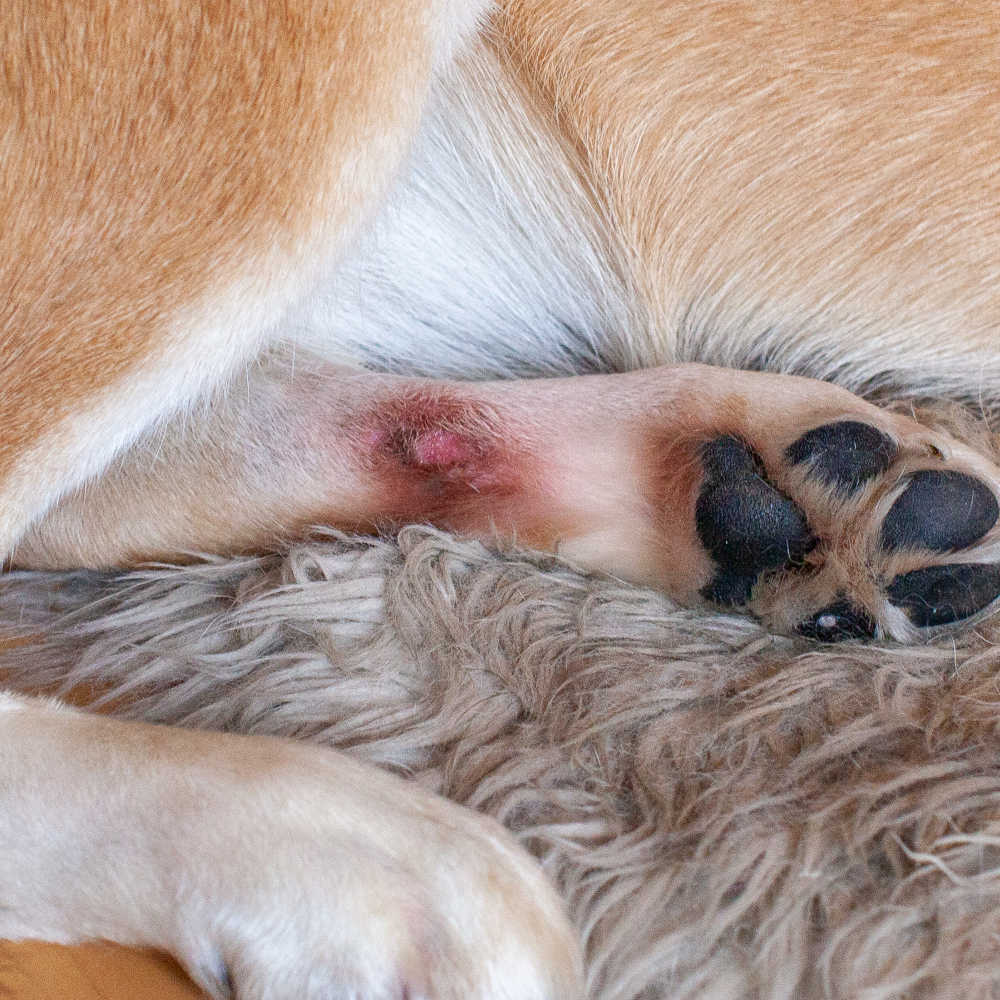
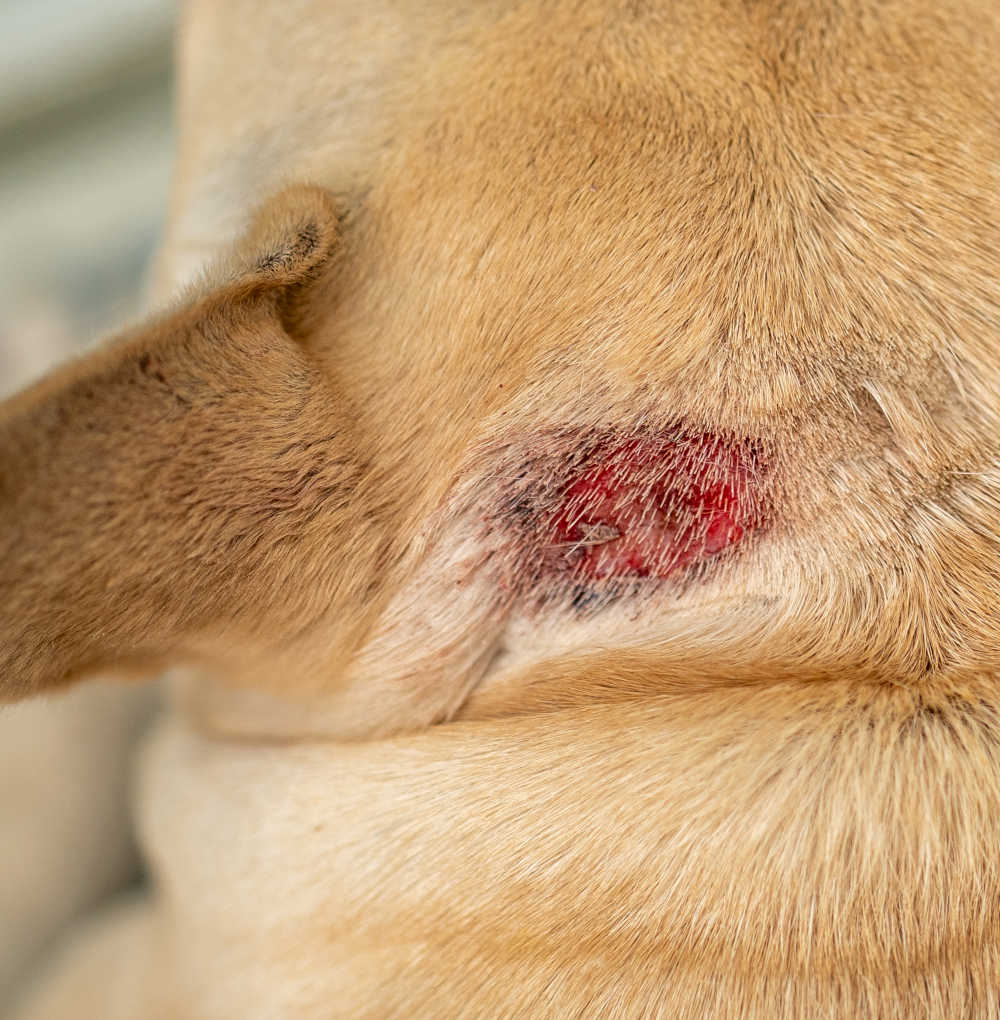
Allergic reactions: Allergies can manifest as skin lesions in dogs. For example, due to environmental allergies, the dog’s immune system can overreact to an airborne or contact allergen in their environment. This overreaction produces skin inflammation in the form of itchiness, redness, and heat, as shown on the picture below. View more pictures of dog skin allergy and rashes, with vet explanations.
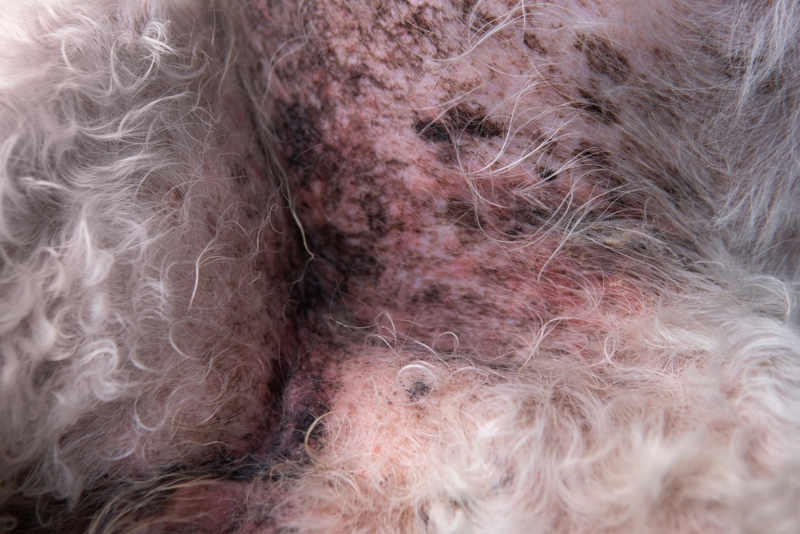
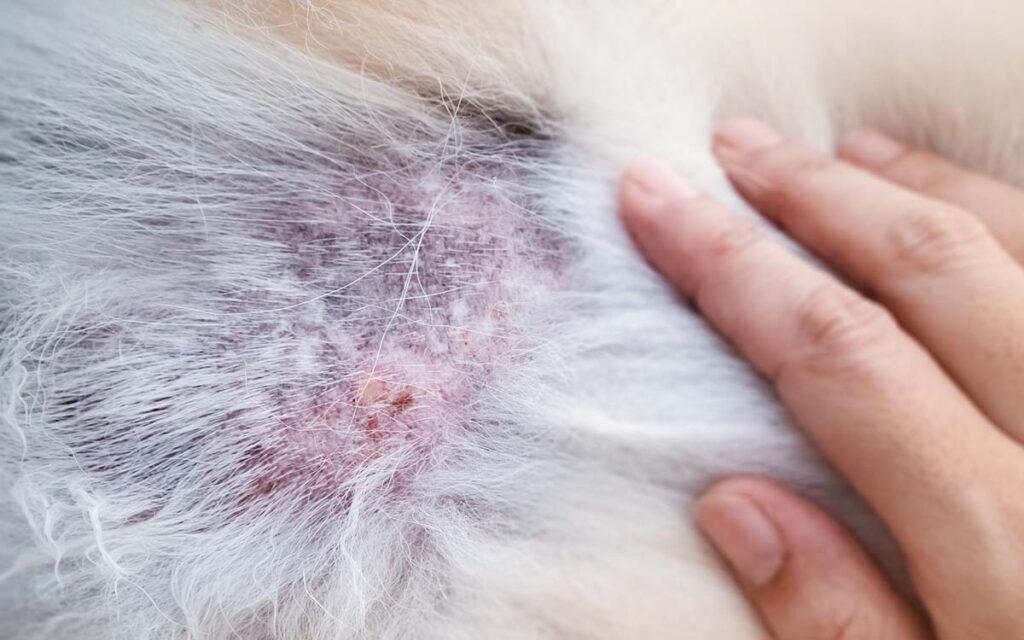
To learn more, view our page listing the most common skin problems in dogs, or read our FAQ about skin infections below:
FAQ
Will my pet insurance cover treatment for skin infections?
It depends on your insurance plan. Some plans are wellness-only, meaning they cover routine checkups, vaccinations, and some flea and tick prevention. Other insurance plans are accident-only, so they may cover some bloodwork, medications, and diagnostic testing. Accident and Illness plans will likely be the most comprehensive and most likely to cover conditions like skin infections and chronic illness. Check with your insurance provider about your dog’s insurance plan and coverage.
How fast do dogs recover from skin infections?
According to Healthy Paws Pet Insurance’s 2019 study of their insurance claims, almost 1 in 5 vet visits were for skin issues. This was the second most common ailment, only outranked by stomach issues. The good news is if properly diagnosed, most common skin infections are cleared within three weeks of treatment.
However, things may get a bit more complicated when resistant bacteria or underlying diseases complicate treatment. Dogs with chronic allergies, for example, often battle secondary skin infections constantly. The treatment goals differ a bit since the allergy must be controlled to maintain healthy skin and prevent subsequent infections.
Key Tip: Always finish all the medications prescribed for your dog’s skin infection unless told otherwise by your veterinarian. While you may see improvement in the skin within a few days, there are often still bacteria present.
Is there any kind of food that can help?
A critical component in maintaining skin health is a well-balanced diet. Vitamins, as well as fats like omega-3s, play an essential role in skin health. Most commercial diets are already balanced in fats and protein. If your dog has ongoing skin issues, though, it is best to consult your veterinarian about any dietary supplements or specific diets that may be beneficial.
How do dogs get skin infections?
Under normal circumstances, your dog’s immune system will usually control the bacteria commonly found on the skin. Still, there are times when bacterial growth is out of hand, and the body can’t keep up.
Anytime the skin is compromised, the dog is more at risk for infection. This compromise includes any physical trauma to the skin that disrupts the skin barrier – itching and scratching due to allergies break down the layers of the skin and make clearing infections more difficult.
Dogs with certain diseases like Cushing’s disease or diabetes are also more likely to develop skin infections since they already have a weakened immune system that is less prepared to fight off invaders.
How do skin infections happen?
Did you know it is normal to find some bacteria on the skin? Your dog has many bacteria on his skin that live in harmony with his immune system, even helping to protect him from more harmful bacteria. The skin also has other mechanisms that help prevent less desirable bacteria from taking over and causing infection: skin cells are routinely shed along with superficial bacteria; oils in the skin prevent bacteria from penetrating deeper layers; specialized cells in the skin that are part of the immune system also help ward off infections. When these protective mechanisms break down – from allergies, licking and chewing, or immune compromise – the skin is overrun with harmful bacteria.
Can I get antibiotics for my dog without seeing a vet?
Typically your veterinarian will want to see your dog and look at his skin before prescribing an antibiotic. The reason is that there are so many causes of skin infections, and not all of them are bacterial and may not respond to antibiotics; instead, they may require additional testing and medications.
Additionally, your vet may want to send a sample for culture to determine the exact bacteria and its susceptible antibiotics. In that case, it is best to get this sample before starting any antibiotics.
What dog breeds are more prone to skin infections?
Any dog can develop a skin infection, but some breeds are more predisposed than others. English and American bulldogs, German shepherds, labradors, and Pitbulls are all breeds that are more prone to skin issues. Any dog with prominent skin folds is more at risk for skin fold infections. Pitbulls tend to have chronic allergies, making secondary bacterial and yeast infections common. Labs, spaniels, and shepherds are known to get recurrent ear infections.
Are skin infections in dogs contagious for humans or other pets?
Certain infections like Staph and ringworm are contagious and can spread from pet to owner. Just like with immunocompromised pets, humans that have weaker immune systems are much more at risk of catching a bacterial infection from their pets.
Good hygiene becomes especially important when your pet has an infection. Frequent decontamination of your house, concentrating on areas where your dog sleeps and spends the most time, is critical in controlling infection spread and handwashing anytime you pet your dog.
A note about ringworm: Keep in mind that in pets, even bacterial infections can have a circular or “ring-like” appearance, so it may not be ringworm. It is always best to have your veterinarian examine any concerning skin issues in your dog – especially if anyone in the house also has skin concerns. Make sure to advise your human doctor that your dog is being treated for ringworm if you are also experiencing skin issues.
Disclaimer: This website's content is not a substitute for veterinary care. Always consult with your veterinarian for healthcare decisions. Read More.





Be the first to comment